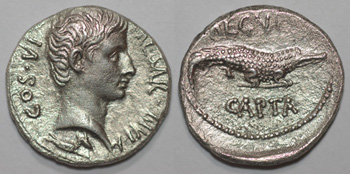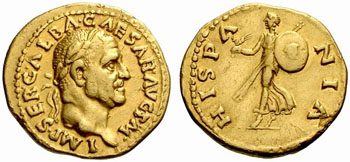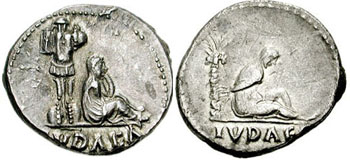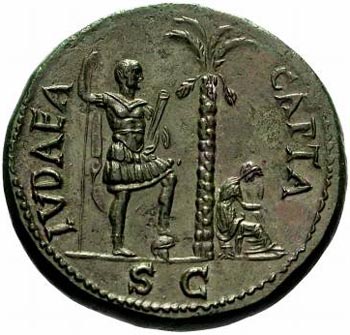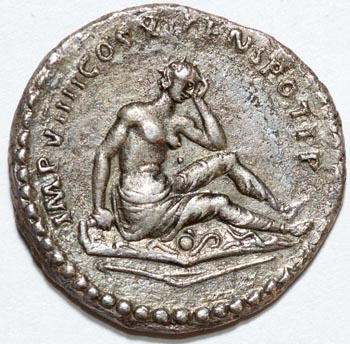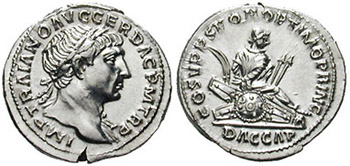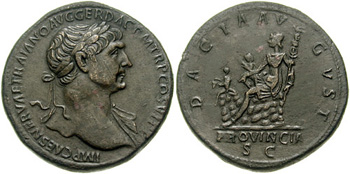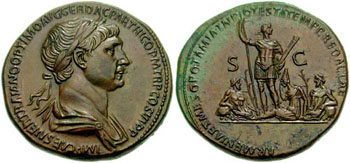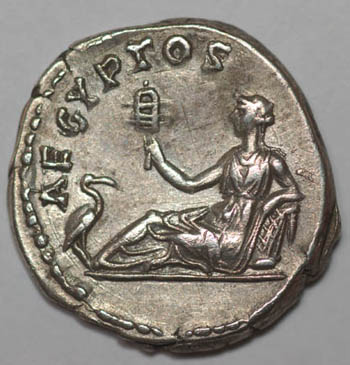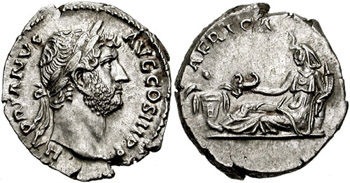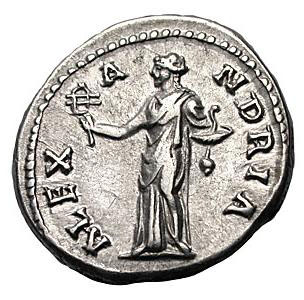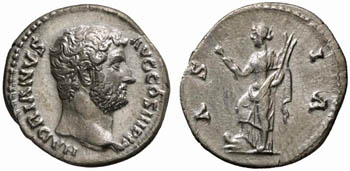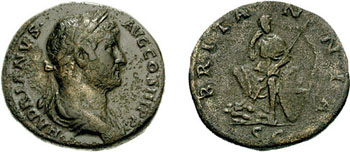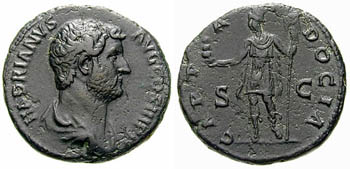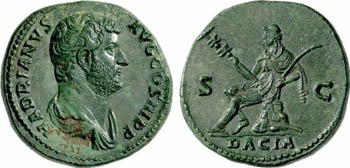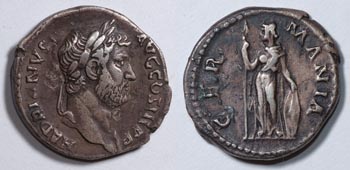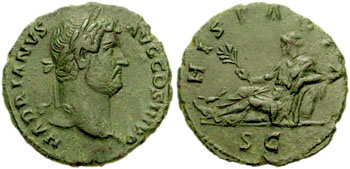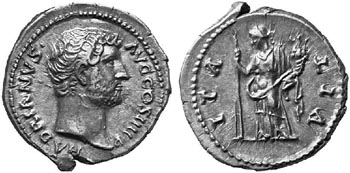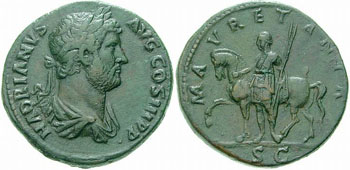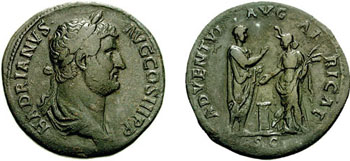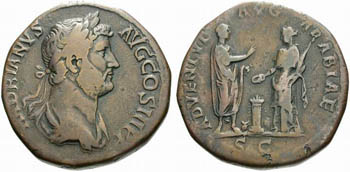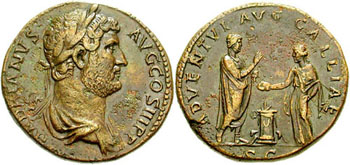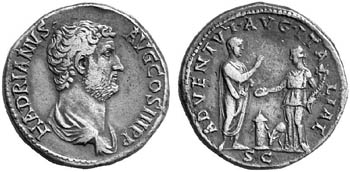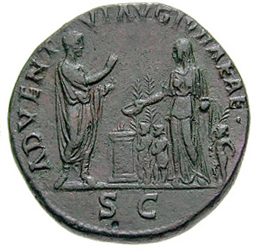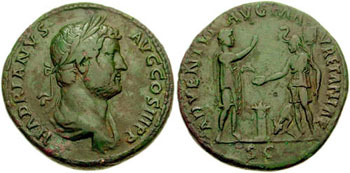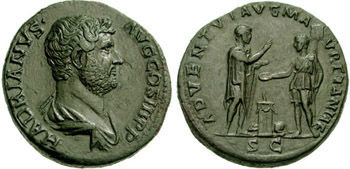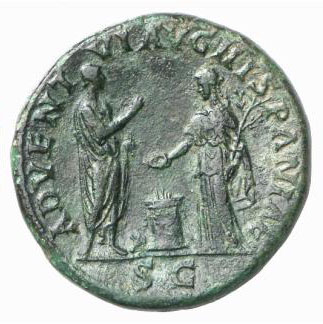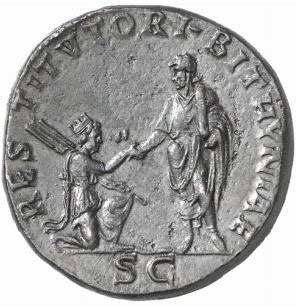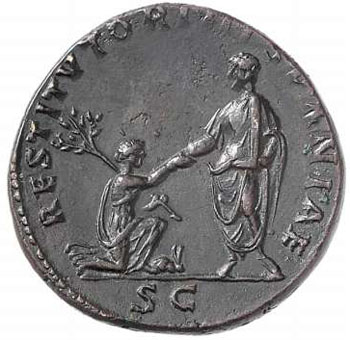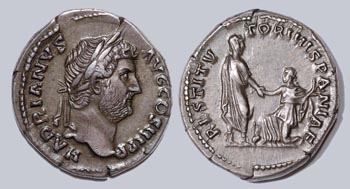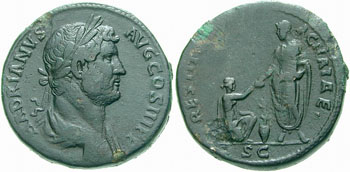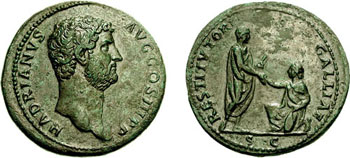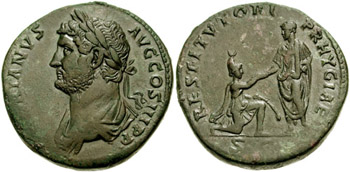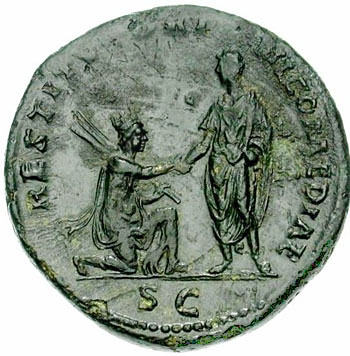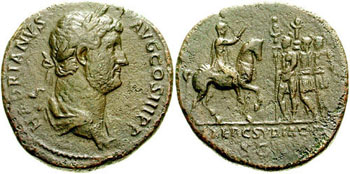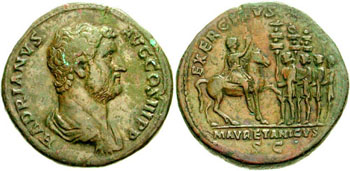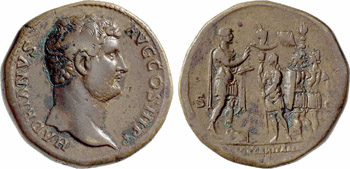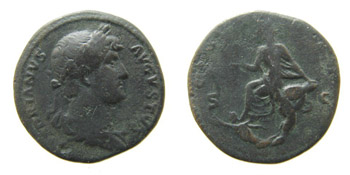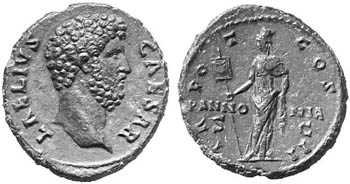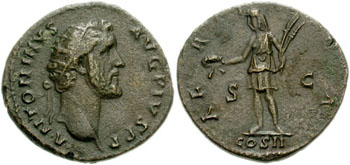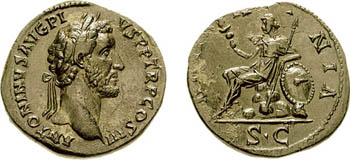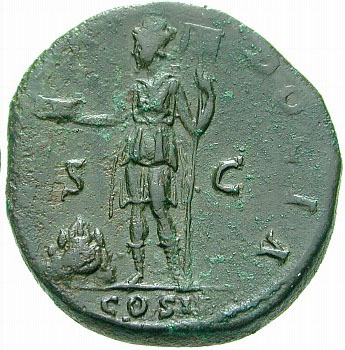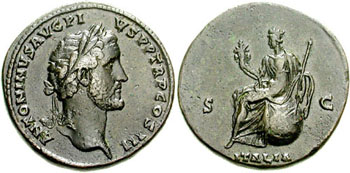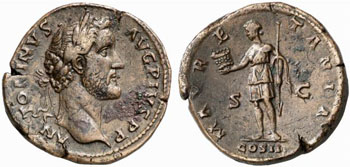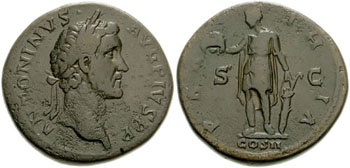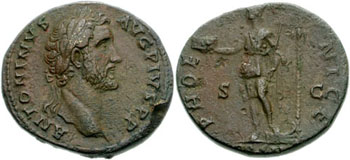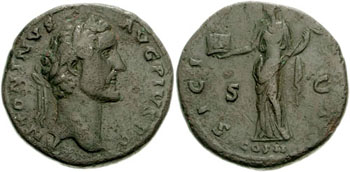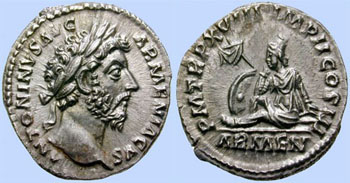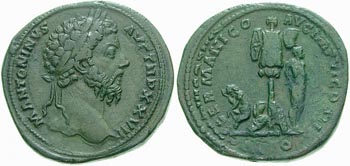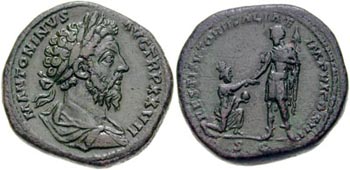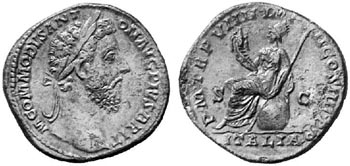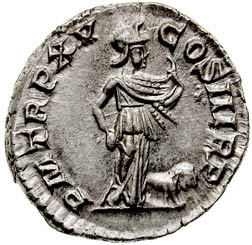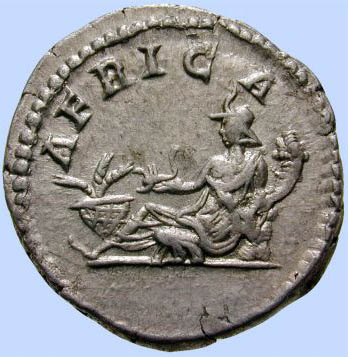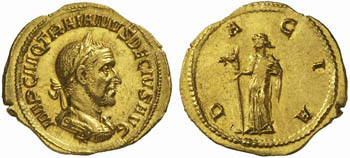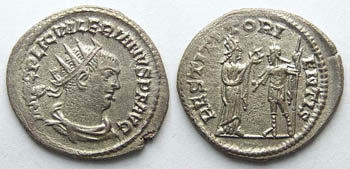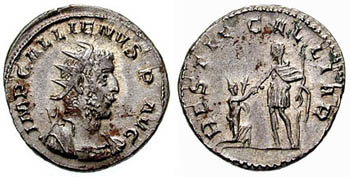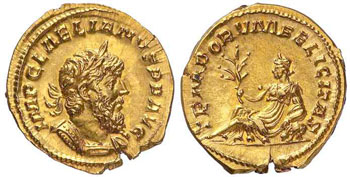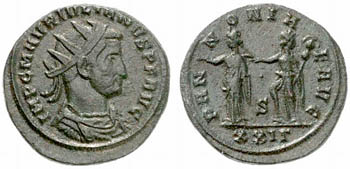Provinces and regions |
|---|
The provinces of the Roman Empire were represented in various ways on Roman coinage. Octavian's (Augustus's) victory over Marc Antony and Cleopatra was celebrated by issuing of denarii with the legend AEGVPTO CAPTA. On the coins, Egypt is represented by a crocodile :
Later, provinces were represented by a human figure, as shown on this aureus issued by Galba.
Several coins issued by Vespasian illustrate the suppression of the Judaean revolt by his son Titus. On the two denarii below, the representation, which appears similar, is in fact quite different. (On this subject, see a politically incorrect coin" : ) :
On Domitian's denarii Germany is shown in an attitude of lamentation, with the hand at the forehead and the chest bared as a sign of despair, as was usual by the Gauls during the Gallic wars. The broken spear at the side completes the scene: Germania is on the ground, even though historical reality was something quite different. (follow up) ) :
NB : See also (1) Dacia, hands tied behind her back, is shown on coins to celebrate the victory of Trajan against Decebalus :
Dacia appears much more peaceful as a province, on a sestertius issued later :
Trajan, after reducing Mesopotamia and Armenia to provincial status, represented Mesopotamia on his sestertii. He showed her in an attitude of lamentation, together with the two rivers, the Tigris and the Euphrates, at the feet of the victorious Emperor :
Hadrian's Provincial series Hadrian undertook a huge tour of the empire. In about 110 AD he visited the provinces of Gaul and Germania before reaching Britain, where he ordered the construction of the wall which is still visible and which carries his name to this day. He continued down to Spain, then crossed the empire in the direction of Asia Minor. He returned to Rome in 126 AD, not without having visited Sicily. Towards 128 AD, he began a second tour, which took him to Africa, Syria and Palestine. He then visited Egypt. His travels through the provinces were the subject of an important coinage emission : In some cases only the province is represented : - Egypt, Rome's granary, holding a sistrum, grenier à blé de Rome, holding a sistre, elbow resting on a full basket, an ibis at her side :
- Africa, holding a scorpion, an elephant headdress on her head :
- Alexandrie :
- Asia, foot on prow, holding a hook and rudder :
- Britain :
- Cappadocia, towered headdress, holding a standard and a miniature of Mount Argaeus :
- Dacie, holding a vexillium and a curved sword:
- Germania, holding spear and German shield :
- Hispania :
- Italia :
- Mauretania, holding a horse by the reins:
NB : There are also other coins : IVDAEA and SICILIA
ADVENTVI : In another of his coinage series, the emperor himself is represented visiting the embodied personage of the province. Note that the province in question always holds a patera above a flaming altar, which represents the emperor's cult :
Mauritania is represented with or without an elephant headdress:
NB : Other coins of the series are: ASIAE, BITHYNIAE, CILICIAE, MACEDONIAE, MOESIAE, NORICI, PARTHIAE, PHRYGIAE, SILICIAE, THRACIAE.
RESTITVTORI : Hadrian is also shown as the restorer of the provinces, helping one or the other region to raise itself up again : Hispania, for example, next to whom we can see a rabbit, and many other regions as well : Gaul, Phrygia, Bithynia, Africa, Achaïeus, Italia, Arabia, Asia, Lybia, Macedonia, Nicomedia and Cilicia.
|
|---|
EXER(CITVS) : In addition, the military organisation of the provinces is often represented by the emperor on horseback, visiting his troops stationed in the various provinces of the empire :
NB : There are also : CAPPADOCIVS, DACICVS, GERMANICVS, HISPAN(ICVS), MOESIACVS, NORICVS, RAETICVS and PARTHICVS.
Antioch is represented on a rare as of Hadrian, in the form of Tyche, with the embodiment of the River Orontes at her feet :
Note that Pannonia is also represented on the as and sestertii of Aelius Caesar, named governor of Pannonia in 137 AD :
Antoninus Pius' series: Securing the Empire Antoninus Pius was not such a great traveller as Hadrian, but this did not prevent him from spending some time in the provinces, at roadworks and for the construction of a second wall in Britain a little further north than the one commissioned by Hadrian :
NB : There are also : ASIA, DACIA, HISPANIA, SCYTHIA, SYRIA, and THRACIA. Marcus Aurelius and his son co-emperor Lucius Vérus reverted to previous depictions to illustrate conquered regions on their coinage :
Like Hadrian before him, Marcus Aurelius is also depicted as the restorer of Italy :
Italia is again represented on a coin of Commodus :
Septimius Severus was born in Africa and so it comes as no surprise that Africa is represented on his coins, accompanied by a lion, or reclining, holding a scorpion, as she was on coins of Hadrian :
Under Trajan Decius, Pannonia, his native province, reappears, albeit rarely in the form as it did on the coins of Aelius Caesar, but more often in the form of a couple, Upper and Lower Pannonia :
Dacia is also depicted on several of Trajan Decius's coins, sometimes she is holding a kind of baton ornamented with a dragon's head-like object, a kind of military insignia adoped by some Danubian legions :
The Orient is represented on some coinage issued by Valerian I, on which she is depicted by a woman wearing a towered headdress.
His son Gallienus restored for one of his reverses a theme which had been dear to Hadrian, presenting himself as the restorer of Gaul :
The true restorer of Gaul, Postumus, claimed this title on the reverse of one his antoniniani. Note that Hispania is depicted on a rare aureus of Laelianus :
The usurper Julian copied his earlier predecessor Trajan Decius by using the two Pannoniae type :
Frédéric Weber |
||||||||||||||||||||||||||||||||||||||||||||||||||||||||||||||||||||||||||||||||||||||||||||||
|---|---|---|---|---|---|---|---|---|---|---|---|---|---|---|---|---|---|---|---|---|---|---|---|---|---|---|---|---|---|---|---|---|---|---|---|---|---|---|---|---|---|---|---|---|---|---|---|---|---|---|---|---|---|---|---|---|---|---|---|---|---|---|---|---|---|---|---|---|---|---|---|---|---|---|---|---|---|---|---|---|---|---|---|---|---|---|---|---|---|---|---|---|---|---|
